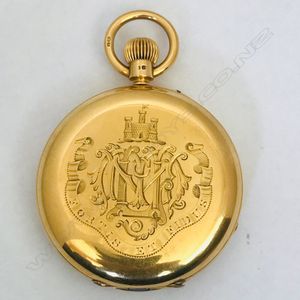Victorian 18ct Gold Hunter Pocket Watch by Edward F Ashley
Victorian 18ct gold hunter pocket watch, by Edward F Ashley, 2 Green Terrace, Clerkenwell, number 05039, 51 mm plain case with crest motto and monogram to front cover, and gold interior dust cover, hallmarked London 1882. Signed white dial, Roman numerals, subs seconds dial at VI. Fully signed fine quality half plate movement with lever escapement. 135gm. Crested: A triple turreted tower set upon a rock. Monogrammed: 'McL'. Motto: 'Fortis Et Fidus' (Brave and Faithful). The crest and motto of Scottish Clan MacLachlan.
You must be a subscriber, and be logged in to view price and dealer details.
Subscribe Now to view actual auction price for this item
When you subscribe, you have the option of setting the currency in which to display prices to $Au, $US, $NZ or Stg.
This item has been sold, and the description, image and price are for reference purposes only.
- Lever Escapement - A lever escapement is a type of escapement mechanism used in mechanical clocks and watches to regulate the timekeeping of the movement. It was invented by British clockmaker Thomas Mudge in the 18th century and is now widely used in modern mechanical timepieces.
The lever escapement consists of three main parts: the escape wheel, the pallet fork, and the lever. The escape wheel is a wheel with teeth that is driven by the clock or watch's main spring or weight. The pallet fork is a two-pronged component that is positioned so that it can engage with the teeth of the escape wheel, and the lever is a small, L-shaped component that is attached to the pallet fork.
When the escape wheel turns, one of its teeth pushes against one of the pallet fork's prongs, causing the fork to pivot. As the pallet fork pivots, it releases the tooth and engages with the next tooth on the opposite side of the escape wheel. At the same time, the lever, which is connected to the pallet fork, rocks back and forth, allowing the escape wheel to turn at a regulated rate.
The lever escapement is prized for its accuracy and reliability and is commonly used in high-end mechanical watches. It allows for precise timekeeping by ensuring that the movement of the watch or clock is regulated and consistent, and its compact size makes it an ideal choice for use in small, portable timepieces. - Hunter - A hunter pocket watch is the type where the case includes a spring-hinged circular metal lid or cover, that closes over the glass face of the watch, protecting it from dust, scratches and other damage or debris. The majority of antique and vintage hunter-case watches have the lid-hinges at the 9 o?clock position, suiting the right handed user.
- Victorian Period - The Victorian period of furniture and decorative arts design covers the reign of Queen Victoria from 1837 to 1901. There was not one dominant style of furniture in the Victorian period. Designers used and modified many historical styles such as Gothic, Tudor, Elizabethan, English Rococo, Neoclassical and others, although use of some styles, such as English Rococo and Gothic tended to dominate the furniture manufacture of the period.
The Victorian period was preceded by the Regency and William IV periods, and followed by the Edwardian period, named for Edward VII (1841 ? 1910) who was King of the United Kingdom and the British Dominions and Emperor of India for the brief period from 1901 until his death in 1910. - Movement - The technical name for the workings of a clock or watch, and does not include the dial or case.
This item has been included into following indexes:
